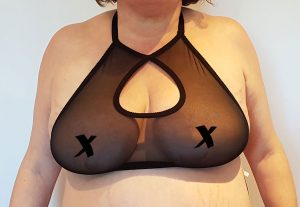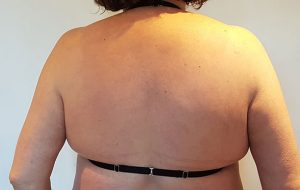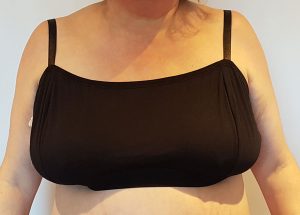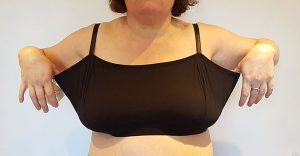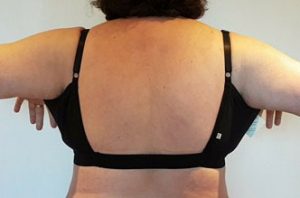Designer Brands Promising Inclusivity and Delivering None.
Ok, this was supposed to be a review of two Neon Moon “bras”. But instead, it has highlighted to me how some companies create their own designer size chart as a means of using “inclusiveness” and “body positivity” to increase sales and brand recognition but, don’t deliver.
When I first saw Neon Moons products a little over a year ago, I was excited by their innovative design in soft bras/bralettes. I was really excited about finally setting aside some cash for what I saw was an investment in a new company who claimed ethical practices and inclusion in both gender and size. They had their own labelling for sizes designed to make customers confident in owning their own shapes with names like “Lovely”, “Gorgeous” and “Beautiful” for regular sizes and “Fabulous” and “Stunning” for plus sizes. It has been very difficult to get my greedy hands on the BOF bra because of its propensity to be sold out every time a new batch was released. So, I signed up for their newsletter and watched my email for the next line launch.
Neon Moon is a UK company who currently manufactures in Great Britain. So you would think they were familiar with standard measurements in plus sizes, right?
#HeadDesk
According to their size chart, my measurements 47.5″ bust (40DD) fall in between Fabulous and Stunning. I ordered two bras, the BOF in black in “Stunning”/UK size 22-24 and the new Oliva Halter Mesh Bra in “Beautiful/Fabulous” 16/18. What I got was another story altogether.
The Oliva “sized up small”. I absolutely hate that btw. Size up small – either it is correctly sized to the measurements THEY supply on their OWN size chart – or it isn’t. Now I have many friends who are a size 16, and this chart does nothing for those who are just above the average cup, for plus size, endowed. And despite this being made of really stretchy mesh, there is NO WAY this bra would have even covered, say one of Loula‘s boobs. It certainly didn’t cover mine which are a modest D/DD. But the main issue was not the side spillage, although there was plenty of that. Even at completely extended, the collar was very tight. Really uncomfortably so and because there was no ease, all of the weight of the bra cut into the back of my neck.
The real disaster of the BOF bra was the size I ordered that was supposed to fit. Stunning, it was not. The bra was 4 inches too large on BOTH SIDES. Yep, an extra 8 inches of bra. From, I really should have ordered a size larger to WTAF.
Now here’s the crux of the matter. The size chart says Stunning: 47-49 inch bust, 4XL 22-24… And on the receipt… drum roll for dramatic effect… Stunning = 5-6XL. Yes, I was stunned alright.

Basics, b*tches!
There are two what I call “anchor sizes”, 18 and 24, which are the most commonly bought plus sizes. As such they should have standard measurements across all UK clothing manufacturers. To check this I compared the size charts of; Evans, Yours, M&S, Asos and Sainsbury’s TU. Each of the first 4 all had the same measurements with an error variant of ≅ 1 inch. TU sized larger at 2-3 inches per size. So, my hypothesis of anchor sizes is valid. There are standard measurements for plus sizes. Manufacturers produce a stable product that customers can go in and simply pick the size off the rack and know what they are getting.
I chose 5 UK lingerie designers who are known for being “inclusive” or have recently extended their lines upward into plus sizes; Neon Moon, Dottie’s Delights, Kiss Me Deadly, Playful Promises and Ninex. Rather than be hypocritical I also added my own size chart for my line of lingerie as well. On the happy side there were two brands that won in the chart comparison game; Playful Promises and my own line. The measurements per sized matched. On the downside, there was a wild mashup of numbers and misleading labels. Please view the Size Chart Comparison 6-11-17 for all results.
The biggest misleading label was the number of X’s used to qualify a size. This is really a problem of misdirection designed to fool the customer into thinking that a brand is more inclusive than it is. The major UK plus size brands define L as a size 18. You got it. Companies who make ALL SIZES define L as an 18. A size 24 = XL – XXL.
First case; Dottie’s Delights. This is the third time I have checked their size chart in the past two years and have discovered new numbers. I hope this means that they are working on getting them right. But the issue here is that this is their definition of what they believe an S-M-L-XL chart should look like – there are no standard sizes added to help the customer choose. So while the brand can now claim that they cater up to 3XL (UK 26-28), the reality is that the bust is a UK 24 (2XL), but the knickers are a UK 20-22. There are many brands who are no more helpful, Neon Moon defines 16 as 2XL, 18 as 3XL and 24 as anywhere between 4-6XL (for one size!). NineX goes one further with 18 as 3XL and 24 as 5XL.
The second most deceptive aspect are the measurements defining what a “standard” size is for that particular designer. Kiss Me Deadly’s measurements for 16-18 are well below that of a standard 18. Basic measurements are that of a size 16. next Ninex who’s 3XL numbers are just skimming the bottom of an 18 but also represents a 20 as well! Plus, Ninex’s 5XL puts them 3+ inches smaller on measurement for a 24. But Neon Moon takes the cake here: their 3XL 18 bust measurement stops at 45 inches and the next size up, 4XL 24, skips 2 inches to 47-49. There is no size in between. Evidence has shown me that there’s really no 4XL 24 either as what I got as the “Stunning” was labelled 5-6XL. The mind completely boggles as to why! What can brands possibly gain by having such confusing, incomplete and simply poor sizing standards?
Why is this distinction between designer charts and standard measurements so important?
Now, it is a thing that some designer’s sizes are different to the marketplace, there are quite a few who have made their name on the concept “you have to be thin enough to be worthy of me”. Abercrombie & Fitch come to mind. But those designers aren’t trying to hide the fact that they size smaller behind a facade of “inclusiveness”. Victoria’s Secret is very upfront about the fact they are dicks. But quite a few brands out there have changed their entire add campaigns, changing their previous standard size 6-8 models in favour of a plus model in their largest manufactured size under the banner of “inclusive” and “body positive”. So, why claim inclusive plus sizes if you don’t have them? Customers who are those printed standard sizes are going to buy the items and then be disappointed when they don’t fit and then blame themselves for the mistake. Every time a customer opens an item to find it doesn’t fit is soul crushing. Many brands even state that’s why they became designers to address just this issue. And then pull this shit. How is that inspiring body positivity?
These days being seen as “not inclusive” makes you the bad guy. But, so does changing your image to false inclusivity by saying, “Hey, we too now suddenly out of the blue make clothes for fat people!” when you actually don’t make clothes for actual fat people and you haven’t actually expanded your range just made it look like you did. Or worse yet added the one token size that fits all fat over a size 18 because you don’t really know what you are doing or give that much of a damn. And the not giving a damn shows! When you don’t size well as part of your service. When you size small or mislabel a 3XL believing it doesn’t matter. When you create “fat is fabulous” imagery but don’t actually have product. You are disrespecting actual plus size people. Worse than that you are adding to the stigma of plus size and belittling body positivity to only those who fit your stilted version of what is “acceptable plus” – all for profit. But what does it matter to them? It’s not like boycotting their lines means anything from a consumer base that can’t buy their product anyway.
Check the size chart BEFORE you buy.
Check the brand’s size chart very carefully! If they say they are inclusive and aren’t – use their contact forms to tell them what your size is and that their measurements don’t match. Support brands who actually do provide accurate and standard size charts. Then spread the love.
Have you ever been caught out by a brand claiming inclusivity and weren’t? Tell us your stories!


